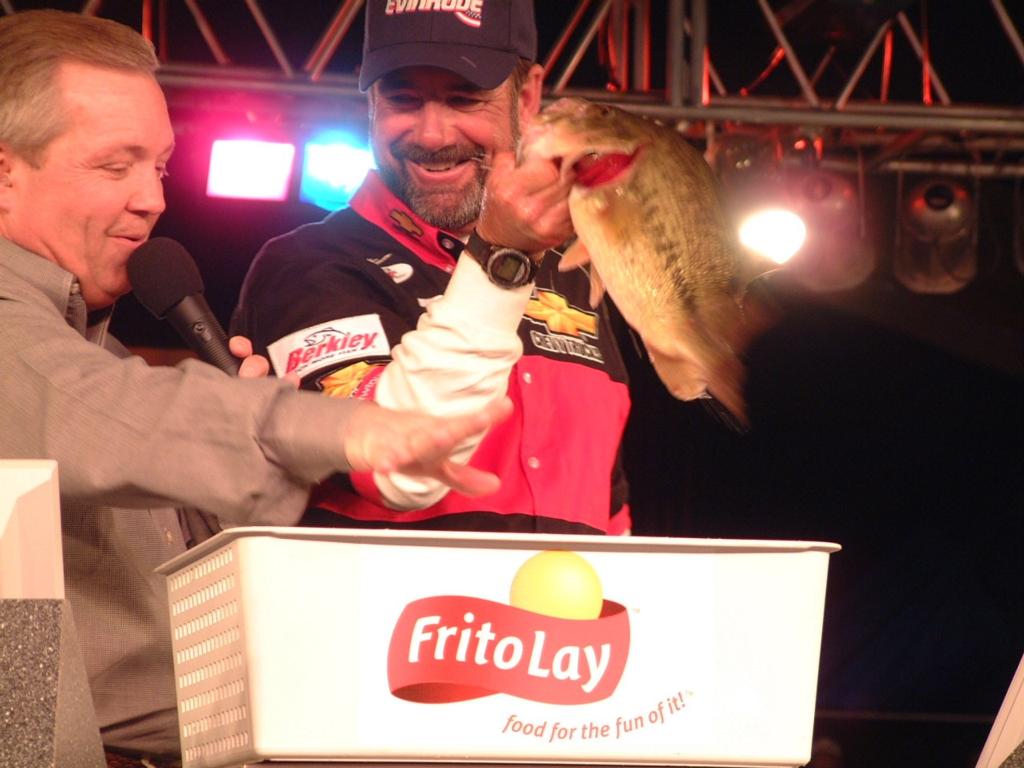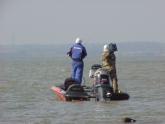Winning ways at Wheeler

Examining the primary fishing patterns of Nixon and Jones on Lake Wheeler
When one door closes, another opens. Larry Nixon’s version of the adage is when one fishing pattern ends, another one begins. That notion sums up Nixon’s FLW Tour victory Feb. 16 on Lake Wheeler.
From the beginning, it looked as if the Lake Wheeler event belonged to Texas angler Alton Jones. Jones took an early lead on day one with 16 pounds, 10 ounces, and turned it into a commanding lead on day two with a limit weighing 19 pounds, 3 ounces. His two-day total of 35 pounds, 13 ounces was almost 10 pounds ahead of second-place angler Mark Rose.
But as all FLW fans know, such a commanding lead is meaningless on the dawn of day three when weights are reset to zero for the top 20 semifinalists. However, Jones made sure that his tremendous day-two weight did not come at the expense of his primary fishing spots. In fact, the majority of his catch on the second day of competition came from experimental forays around Lake Wheeler.
“I went into my primary area and caught a 3-pounder and a 4-pounder in 15 minutes and I figured I was in,” said Jones on his day-two strategy. “After that, I just went practicing, looking for similar water and just kept catching big ones.”
 Jones’ “similar water” consisted of channel bends in the many ditches that traverse Lake Wheeler’s famous Decatur Flats. He was fishing a 1/4-ounce Riverside jig (black/blue and greenpumpkin) tipped with a Riverside Beavertail chunk. He fished the jig on the stump-lined bends of several ditches.
Jones’ “similar water” consisted of channel bends in the many ditches that traverse Lake Wheeler’s famous Decatur Flats. He was fishing a 1/4-ounce Riverside jig (black/blue and greenpumpkin) tipped with a Riverside Beavertail chunk. He fished the jig on the stump-lined bends of several ditches.
“The creek channels are 8 to 10 feet deep, and the tops of the bends are in 4 to 6 feet of water,” said Jones.
Jones used a Fenwick Techna AV rod, 6 feet, 6 inches in length, with a medium-heavy action. He tied the jig to a 20-pound test Berkley Vanish fluorocarbon leader, which was then tied to 30-pound test Spider Wire braided line. His reel was an Ambassadeur 4600C5 Mag.
According to Jones, there were other competitors in his areas, but they were fishing too fast to catch the big fish. A key to his big fish bite was crawling the jig through the stumps slowly and shaking the jig’s rattle to entice the lethargic bass into biting.
“The water temperature is 46 degrees. These fish are not in a chasing mood,” said Jones, revealing his tournament mindset.
Jones further demonstrated a mastery of the jig on day three when again he brought in the day’s biggest limit of 12 pounds, 9 ounces. However, by the end of day three, things were beginning to change on the Decatur Flats. The water level, which had been steadily dropping during the first two days, began to come back up. Many of the stumps that were visible in the low water and sunny conditions of day two, were beginning to disappear into rising water and cloudy skies.
By the time day four had commenced, the wind was already battering the flats and causing Jones to revamp his approach.
“The fish were there, I just could not fish them correctly in the wind,” said Jones, who ultimately finished in third place with 8 pounds, 9 ounces. “The only time the wind let up was from 11 a.m. to 12 noon, which is when I caught the three keepers.
“If I had it to do over, I would not change a thing,” Jones added. “I never lost a fish all week and, technically, I fished a perfect tournament, and that feels pretty good.”
Nixon goes in a different direction
Like Jones, Nixon had discovered a fish-producing pattern in the Decatur Flats area of the lake during the first three days. On the first two days of competition, Nixon fished a Berkley Power craw and a 1/4-ounce Strike King Diamond Shad lipless crankbait along ditches and stump beds in the flats.
On day two, Nixon made a move in the standings with a limit weighing 14 pounds, 4 ounces to make the semifinals. Nixon also attributed his day-two catch to lower water levels and bright sun.
“Not only does the lower water help concentrate the fish into those ditch channels, but it also allows you to see the stumps, making fishing much more efficient,” said Nixon.
Unlike Jones, who again led the pack going into day four, Nixon barely made the cut. His day-three weight of 5 pounds, 15 ounces actually tied him for the 10th-place position, but Nixon had the bigger day-two stringer so he advanced.
In fact, at one point, Nixon thought he had missed the cut.
“I sure would like to go out there and try them again tomorrow,” he said. “I think I could do well.”
His statement was prophetic. What Nixon knew was that significant weather and water changes were coming – the kind of breaks that open one door and close another. So, instead of running to Decatur Flats on day four, Nixon pulled a sage trick out of his old fishing cap – he stayed close and fished hard.
Several factors played a hand in Nixon’s altered strategy. One concern was that he was splitting the productive flats of Lake Wheeler with Mark Rose, a top-10 finalist. Another factor was the weather as a strong northwest wind was in the forecast. Also, the water was continuing to rise, allowing concentrations of fish to spread out on the flats. Perhaps the final straw was a 1 p.m. check-in – a consequence that would make day four the shortest fishing day of the entire week.
After weighing the key factors, Nixon decided to toss his “flats” patterns out the window, put the trolling motor down in First Creek and go fishing.
“First and Second Creek are great fishing creeks on Wheeler,” Nixon said after his victory. “Fishing Wheeler over the years, I know the banks in those creeks pretty well. The problem is that during practice, and during the first two days of the tournament, every point has a boat on it and you can’t move around. Once you get the boats out of there and the fish set back up on those drops, then it is just a matter of finding the depth of the strike zone.”
Nixon caught his stunning weight of 16 pounds, 9 ounces on a 1/2-ounce Strike King Premier Elite Jig teamed with a Bo-Hawg Sr. pork chunk (both black/blue). He was using a Fenwick Techna AV rod, 6 feet, 6 inches in length, with a medium-heavy action and an ABU Garcia T3000 reel. Nixon tied his jig to 14-pound test Berkley Vanish fluorocarbon line and fished in depths of 10 to 15 feet.